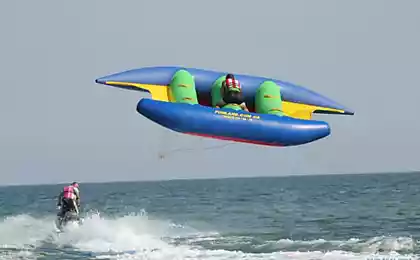446
Technology from the air
A long time ago someone thought that the wind, i.e. the horizontal movement of air relative to the earth, resulting from the uneven distribution of atmospheric pressure, has a force which should not cause to disappear. Let it work.

Blow stronger!
In ancient times, the production of high-quality steel required hard physical effort and huge fuel consumption. But Ceylon metallurgists 300 BC found a great way to solve both problems at once. Best steel products they received during the monsoon season, when the constant strong wind drastically accelerated the burning of charcoal, which allowed faster to make fire in the ovens and to heat them to an incredible temperature. Ceylon experiences the precursors of such well-known technologies of manufacturing of metal, such as damask steel.
Black bird
At different times people and that were crossed two ancient technologies — the wheel and the sail. For example, the Chinese have established the sails on huge carts, to reduce the load on yoked them oxen. And in the XIX century there was a sailing tricycle aeromobili(from the word "Aeolian", which in Greek means wind).
In our time, this hybrid is also relevant. In 2009 in Holland competitions of Racing Aeolus, involving single veromobile. Only instead of sails they are propellers that rotate in the wind and transmit the energy to the wheels. In 2012 one such car — Blackbird — managed to drive against the wind with a speed twice the speed of the wind.
Floating bonfires
It is through the wind was moving the first autopilots. Talking about the fire-ships — ships used to set fire to enemy ships. The first combat ships without crew coped with the wind. The ancient Greek historian Thucydides, describing the battles of 415-413 BCE, mentions, as the Sicilian Greeks had loaded their ships with brushwood was set fire to and released to drift in the wind in the direction of Trier of the Athenians. At that time the Athenians had managed a last-minute escape from the first Brander. But in the year 468, the vandals succeeded in using ships-fires driven by the wind. In the battle of Cape Bon they sent in the onset of his terrible squadron under cover of night. The battle ended with the victory of the barbarians.
Twenty-two bullets at the target
In the XVIII century the Austrian watchmaker Bartolomeo Girandoni created a wind-gun Windbüchse. If the musket was shot three to four times per minute, after which it was required to reload, then wind the gun had first ever store as much as twenty-two bullets at once. One cylinder-butt, inflated to 33 psi, enough to release them all in half a minute. Due to the octagonal rifled barrel Windbüchse superior to the shotgun for the accuracy of the battle.
However, for various reasons efficient air gun is not able to displace primitive muskets. And then the firearm has gone far ahead, leaving the pots and only sports and entertainment application.
Deadly origami
When during the Second world war, Japan was faced with air attacks Americans, the researchers decided to develop an Intercontinental-flying balloons-bombs.
It was a primitive device. Of tarred paper for origami, the Japanese did to the balloons, filled with hydrogen, hung bombs to them and sent adrift. Further left to wait and hope that after three days, the small powder charge would undermine the tether with a bomb, and she falls to the ground.
According to scientists, 10% of the instruments of death had to fall on the heads of Americans. Indeed, thanks to the high-altitude jet wind over all, hovering above the approximately nine kilometers over Japan, with constant speed moving right towards US.
Fortunately, the first Japanese drones do not have time to do as much damage to civilians.
Marshmallow venereum
The concept of the Venusian planetary Rover Zephyr, created by NASA, designed for wind power. The sail on the rope 12 m2 will drag wheel apparatus on a flat surface of Venus without the aid of motors.
But on Venus the wind has a constant speed of 1 m/s — even a pedestrian can move faster. Why rely on such a slow engine and how he will cope with a heavy load? The fact that Venus's atmosphere a hundred times denser than earth's. Therefore, the small sail is enough to move the lunar Rover, weighing one ton.
To reach Uranium
In 2013 the carrier rocket "VEGA" has launched the Estonian-Finnish satellite ESTCube-1. For the first time in history a spacecraft has used electrophorus. For it was need the wind of the earth and the sun stream of charged particles "blown" from the vicinity of the Sun's plasma emissions of the latter. To "harness" this thread, Estonian microsatellite unfolded around the fan cables, which fired the electron gun, powered by small solar panels. Positively charged wires alienate the ions of the solar wind, and the craft flew away from the Sun.
In the beginning of the program, the developers were confident that at this electrophorese research probe can fly to Uranus in six years. For comparison, other modern technologies allow to reach much more close to Saturn not earlier than seven years. Unfortunately, in February, the mission ended in connection with the discharge of the batteries of the satellite.published
P. S. And remember, only by changing their consumption — together we change the world! ©
Source: kot.sh/statya/209/tehnologii-iz-vozduha

Blow stronger!
In ancient times, the production of high-quality steel required hard physical effort and huge fuel consumption. But Ceylon metallurgists 300 BC found a great way to solve both problems at once. Best steel products they received during the monsoon season, when the constant strong wind drastically accelerated the burning of charcoal, which allowed faster to make fire in the ovens and to heat them to an incredible temperature. Ceylon experiences the precursors of such well-known technologies of manufacturing of metal, such as damask steel.
Black bird
At different times people and that were crossed two ancient technologies — the wheel and the sail. For example, the Chinese have established the sails on huge carts, to reduce the load on yoked them oxen. And in the XIX century there was a sailing tricycle aeromobili(from the word "Aeolian", which in Greek means wind).
In our time, this hybrid is also relevant. In 2009 in Holland competitions of Racing Aeolus, involving single veromobile. Only instead of sails they are propellers that rotate in the wind and transmit the energy to the wheels. In 2012 one such car — Blackbird — managed to drive against the wind with a speed twice the speed of the wind.
Floating bonfires
It is through the wind was moving the first autopilots. Talking about the fire-ships — ships used to set fire to enemy ships. The first combat ships without crew coped with the wind. The ancient Greek historian Thucydides, describing the battles of 415-413 BCE, mentions, as the Sicilian Greeks had loaded their ships with brushwood was set fire to and released to drift in the wind in the direction of Trier of the Athenians. At that time the Athenians had managed a last-minute escape from the first Brander. But in the year 468, the vandals succeeded in using ships-fires driven by the wind. In the battle of Cape Bon they sent in the onset of his terrible squadron under cover of night. The battle ended with the victory of the barbarians.
Twenty-two bullets at the target
In the XVIII century the Austrian watchmaker Bartolomeo Girandoni created a wind-gun Windbüchse. If the musket was shot three to four times per minute, after which it was required to reload, then wind the gun had first ever store as much as twenty-two bullets at once. One cylinder-butt, inflated to 33 psi, enough to release them all in half a minute. Due to the octagonal rifled barrel Windbüchse superior to the shotgun for the accuracy of the battle.
However, for various reasons efficient air gun is not able to displace primitive muskets. And then the firearm has gone far ahead, leaving the pots and only sports and entertainment application.
Deadly origami
When during the Second world war, Japan was faced with air attacks Americans, the researchers decided to develop an Intercontinental-flying balloons-bombs.
It was a primitive device. Of tarred paper for origami, the Japanese did to the balloons, filled with hydrogen, hung bombs to them and sent adrift. Further left to wait and hope that after three days, the small powder charge would undermine the tether with a bomb, and she falls to the ground.
According to scientists, 10% of the instruments of death had to fall on the heads of Americans. Indeed, thanks to the high-altitude jet wind over all, hovering above the approximately nine kilometers over Japan, with constant speed moving right towards US.
Fortunately, the first Japanese drones do not have time to do as much damage to civilians.
Marshmallow venereum
The concept of the Venusian planetary Rover Zephyr, created by NASA, designed for wind power. The sail on the rope 12 m2 will drag wheel apparatus on a flat surface of Venus without the aid of motors.
But on Venus the wind has a constant speed of 1 m/s — even a pedestrian can move faster. Why rely on such a slow engine and how he will cope with a heavy load? The fact that Venus's atmosphere a hundred times denser than earth's. Therefore, the small sail is enough to move the lunar Rover, weighing one ton.
To reach Uranium
In 2013 the carrier rocket "VEGA" has launched the Estonian-Finnish satellite ESTCube-1. For the first time in history a spacecraft has used electrophorus. For it was need the wind of the earth and the sun stream of charged particles "blown" from the vicinity of the Sun's plasma emissions of the latter. To "harness" this thread, Estonian microsatellite unfolded around the fan cables, which fired the electron gun, powered by small solar panels. Positively charged wires alienate the ions of the solar wind, and the craft flew away from the Sun.
In the beginning of the program, the developers were confident that at this electrophorese research probe can fly to Uranus in six years. For comparison, other modern technologies allow to reach much more close to Saturn not earlier than seven years. Unfortunately, in February, the mission ended in connection with the discharge of the batteries of the satellite.published
P. S. And remember, only by changing their consumption — together we change the world! ©
Source: kot.sh/statya/209/tehnologii-iz-vozduha
What pisses me off in others or a lonely stocking looking for a mate
How not to become a zombie: the psychology of the crowd






















